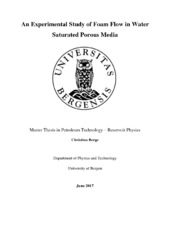| dc.description.abstract | The amount of greenhouse gases in the atmosphere has increased significantly the last 250 years, causing a global temperature rise. CO2 emissions from fossil fuel combustion is a major contributor to greenhouse gas emissions, and carbon capture and sequestration (CCS) has been suggested and to some extent implemented as a mitigation method. This experimental work presents a study of the use of foam in a CO2 storage context. The investigation is part of an on-going project with field pilots in Texas, where the objective is to implement mobility control with CO2 foam for storage and enhanced oil recovery on the Norwegian Continental Shelf (NCS). Foam experiments were conducted in 100% brine saturated sandstone core samples and fractured marble core samples, through co-injection of gas and surfactant solution at low pressure. Foam was pre-generated in a foam generator upon entering the core samples. Quantitative analyses of endpoint water saturations and pressure gradients were conducted, to evaluate the foam flow behavior and displacement improvement compared to pure gas injections. Generated fractures in impermeable marble cores provided a permeability ranging from 1.47 D to 8.03 D. The fractured core samples appeared to be of such a small scale that there was little or no improvement in water production during foam injections compared to pure gas injections. Magnetic resonance imaging (MRI) was conducted for qualitative studies of water saturations, and indicated good sweep efficiency during co-injection of gas and surfactant solution in a marble core with a multi-fracture system. Calculated mobility reduction factors for foam experiments in unfractured Bentheimer sandstone cores indicated an average gas mobility reduction of 3.94, compared to pure gas injections. Resistivity measurements conducted during pure CO2 injections and co-injections of CO2 gas and surfactant solution in sandstone cores were used to calculate water saturations using Archie’s law. Archie’s law is developed for use in an oil-water system, and does not consider the conductivity of the liquid phase in foam displacements. A modification is therefore needed for Archie’s law to be applicable in foam-water systems. | en_US |
